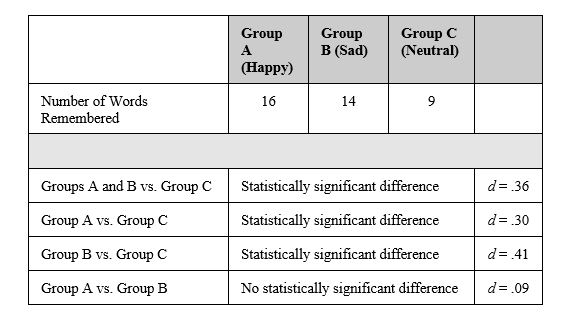RESEARCH STUDY 9.1
Dr. Lonsbary is a cognitive psychologist who is curious about how mood affects memory. She recruited 60 high school students and divided them into three groups. One group (A) listened to a 5-minute piece of music intended to make them feel happy (a song entitled "Don't Worry, Be Happy") . One group (B) listened to a 5-minute piece of music intended to make them feel sad (a song entitled "Alone Again") . One group (C) listened to no music and instead was asked to sit quietly for 5 minutes (thought to make them feel neutral) .
When a participant would come to her laboratory, she would greet the participant and then ask him or her to draw a card. If the participant drew a 1, 2, or 3, he or she was assigned to Group A. If the participant drew a 4, 5, or 6, he or she was assigned to Group B. If a participant drew a 7, 8, or 9, he or she was assigned to Group C. The participants were then given a CD to listen to based on their group assignment. The CD contained the song selection or 5 minutes of silence. There were no identifying marks on the CD indicating what was contained on the disc. They were then escorted into a different room, where they were greeted by a research assistant who conducted the experiment. The research assistant sat the participants in front of a computer screen and told them that a list of 25 words would be displayed on the screen. They were instructed to put the CD in the computer, put on the headphones, and listen to the CD while trying to memorize the list of words.
When 5 minutes had passed, the screen displayed a question asking them whether they felt happy, sad, or neutral. After the participant responded, a new screen was displayed asking them to type in all the words they could remember from the list of 25 words. All participants were given 3 minutes to type the words they remembered. In addition, all participants were given the same list of 25 words to remember. Afterward, the participant was thanked and dismissed. In response to the mood question, a majority of Group A participants said they were happy, a majority of Group B participants said they were sad, and a majority of Group C participants said they were neutral in their mood. Dr. Lonsbary found the following results in response to the number of words remembered.

-Refer to Research Study 9.1 above to answer the following question. Prior to conducting the current study,Dr.Lonsbary asked her research assistant to use the same mood manipulation with a sample of 30 college students to determine if people's moods really did change after listening to the music.This preliminary study is known as a:
A) Pretest/posttest study
B) Concurrent measure study
C) Pilot study
D) Pretest-only study
E) None of the above
Correct Answer:
Verified
Q2: RESEARCH STUDY 9.1
Dr. Lonsbary is a cognitive
Q3: When conducting an experiment,what is provided by
Q4: A threat to internal validity occurs only
Q5: Which of the following is NOT true
Q6: RESEARCH STUDY 9.1
Dr. Lonsbary is a cognitive
Q8: RESEARCH STUDY 9.1
Dr. Lonsbary is a cognitive
Q9: RESEARCH STUDY 9.1
Dr. Lonsbary is a cognitive
Q10: RESEARCH STUDY 9.1
Dr. Lonsbary is a cognitive
Q11: RESEARCH STUDY 9.1
Dr. Lonsbary is a cognitive
Q12: RESEARCH STUDY 9.1
Dr. Lonsbary is a cognitive
Unlock this Answer For Free Now!
View this answer and more for free by performing one of the following actions

Scan the QR code to install the App and get 2 free unlocks

Unlock quizzes for free by uploading documents